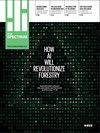软件糟透了,但不必如此:如何制作更精简、更环保的软件
IF 2.6
4区 工程技术
Q2 ENGINEERING, ELECTRICAL & ELECTRONIC
引用次数: 0
摘要
你看不到、听不到、尝不到、感觉不到或闻不到,但软件在我们身边无处不在。它支撑着现代文明,却消耗着比它所需更多的能源、财富和时间,并向大气层排放大量二氧化碳。软件产业及其代码需要提高效率,以尽量减少在数据中心和传输网络中运行的程序所产生的排放。本期介绍的两种软件开发方法可以帮助我们实现这一目标。本文章由计算机程序翻译,如有差异,请以英文原文为准。
Software Sucks, But It Doesn't Have To: How to make leaner, greener software
You can't see, hear, taste, feel, or smell it, but software is everywhere around us. It underpins modern civilization even while consuming more energy, wealth, and time than it needs to and burping out a significant amount of carbon dioxide into the atmosphere. The software industry and the code it ships need to be much more efficient in order to minimize the emissions attributable to programs running in data centers and over transmission networks. Two approaches to software development featured in this issue can help us get there.
求助全文
通过发布文献求助,成功后即可免费获取论文全文。
去求助
来源期刊

IEEE Spectrum
工程技术-工程:电子与电气
CiteScore
2.50
自引率
0.00%
发文量
254
审稿时长
4-8 weeks
期刊介绍:
IEEE Spectrum Magazine, the flagship publication of the IEEE, explores the development, applications and implications of new technologies. It anticipates trends in engineering, science, and technology, and provides a forum for understanding, discussion and leadership in these areas.
IEEE Spectrum is the world''s leading engineering and scientific magazine. Read by over 300,000 engineers worldwide, Spectrum provides international coverage of all technical issues and advances in computers, communications, and electronics. Written in clear, concise language for the non-specialist, Spectrum''s high editorial standards and worldwide resources ensure technical accuracy and state-of-the-art relevance.
 求助内容:
求助内容: 应助结果提醒方式:
应助结果提醒方式:


